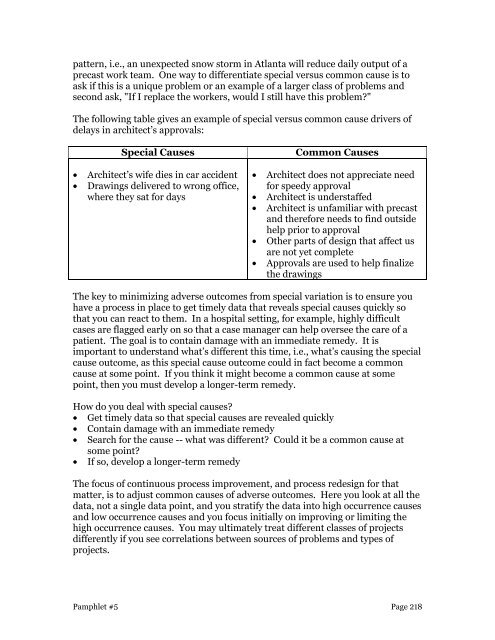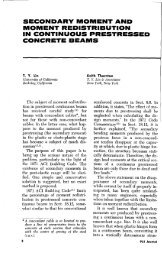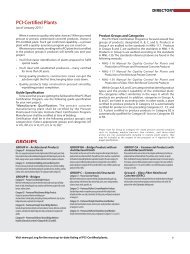Winning Without Competition: How to Break Out of a Commodity ...
Winning Without Competition: How to Break Out of a Commodity ...
Winning Without Competition: How to Break Out of a Commodity ...
Create successful ePaper yourself
Turn your PDF publications into a flip-book with our unique Google optimized e-Paper software.
pattern, i.e., an unexpected snow s<strong>to</strong>rm in Atlanta will reduce daily output <strong>of</strong> a<br />
precast work team. One way <strong>to</strong> differentiate special versus common cause is <strong>to</strong><br />
ask if this is a unique problem or an example <strong>of</strong> a larger class <strong>of</strong> problems and<br />
second ask, "If I replace the workers, would I still have this problem?"<br />
The following table gives an example <strong>of</strong> special versus common cause drivers <strong>of</strong><br />
delays in architect’s approvals:<br />
Special Causes Common Causes<br />
• Architect’s wife dies in car accident<br />
• Drawings delivered <strong>to</strong> wrong <strong>of</strong>fice,<br />
where they sat for days<br />
• Architect does not appreciate need<br />
for speedy approval<br />
• Architect is understaffed<br />
• Architect is unfamiliar with precast<br />
and therefore needs <strong>to</strong> find outside<br />
help prior <strong>to</strong> approval<br />
• Other parts <strong>of</strong> design that affect us<br />
are not yet complete<br />
• Approvals are used <strong>to</strong> help finalize<br />
the drawings<br />
The key <strong>to</strong> minimizing adverse outcomes from special variation is <strong>to</strong> ensure you<br />
have a process in place <strong>to</strong> get timely data that reveals special causes quickly so<br />
that you can react <strong>to</strong> them. In a hospital setting, for example, highly difficult<br />
cases are flagged early on so that a case manager can help oversee the care <strong>of</strong> a<br />
patient. The goal is <strong>to</strong> contain damage with an immediate remedy. It is<br />
important <strong>to</strong> understand what’s different this time, i.e., what’s causing the special<br />
cause outcome, as this special cause outcome could in fact become a common<br />
cause at some point. If you think it might become a common cause at some<br />
point, then you must develop a longer-term remedy.<br />
<strong>How</strong> do you deal with special causes?<br />
• Get timely data so that special causes are revealed quickly<br />
• Contain damage with an immediate remedy<br />
• Search for the cause -- what was different? Could it be a common cause at<br />
some point?<br />
• If so, develop a longer-term remedy<br />
The focus <strong>of</strong> continuous process improvement, and process redesign for that<br />
matter, is <strong>to</strong> adjust common causes <strong>of</strong> adverse outcomes. Here you look at all the<br />
data, not a single data point, and you stratify the data in<strong>to</strong> high occurrence causes<br />
and low occurrence causes and you focus initially on improving or limiting the<br />
high occurrence causes. You may ultimately treat different classes <strong>of</strong> projects<br />
differently if you see correlations between sources <strong>of</strong> problems and types <strong>of</strong><br />
projects.<br />
Pamphlet #5 Page 218







